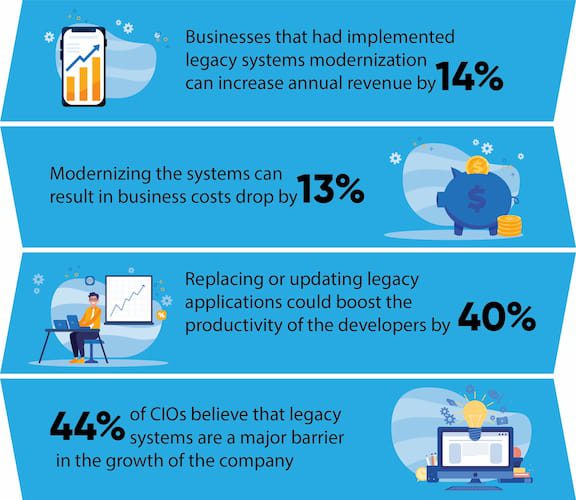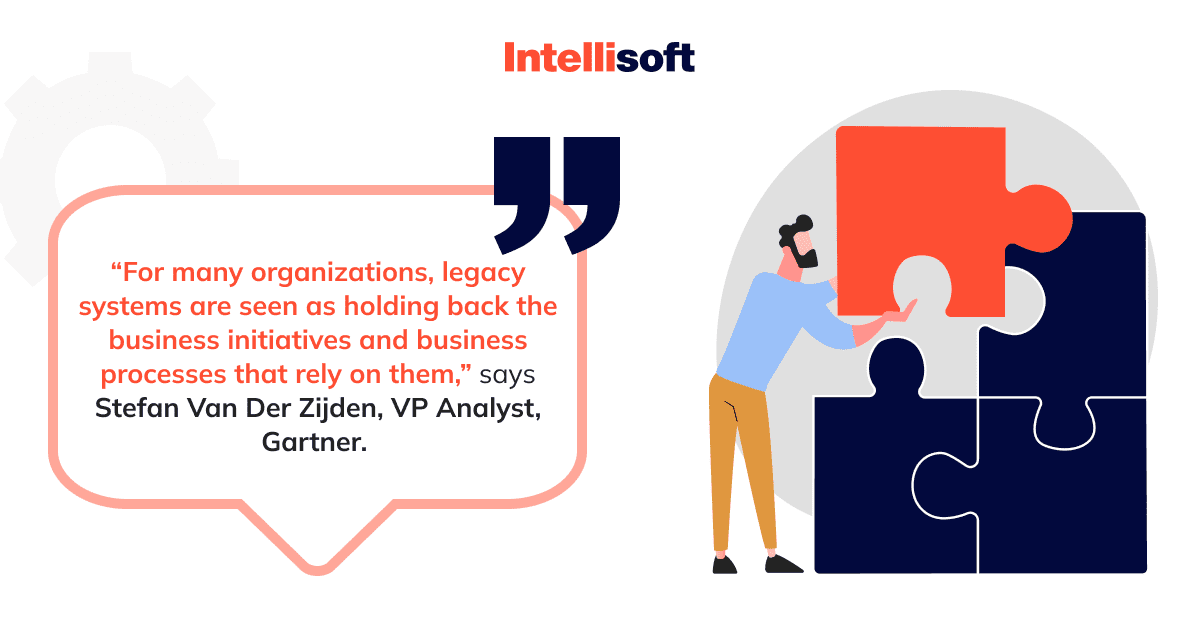In today's fast-moving digital world, technology is advancing so quickly that businesses hardly have time to become familiar with their operating systems before they become outdated or obsolete.
Have you lost sight of your migration destination? Get back on track with Collab Compass.
To allow for expansion, business agility and the digital transformation necessary to keep a competitive edge, organizations are realizing that they need to modernize legacy systems.
 Image source: DataScience central
Image source: DataScience central
Download a PDF of our Hybrid Workplace Guide 2.0

Download a PDF of our Hybrid Workplace Guide 2.0
What is a legacy system?
Legacy systems are basically older computing software, programming languages, and hardware systems that have been outdated in terms of functionality by the introduction of new technology - but companies continue to use.
A legacy application may have been state-of-the-art, and obviously served its purpose when first introduced. However, it's clear that with the way technology, and today's business environment is changing, the functions of legacy applications are becoming insufficient very rapidly.
 Image source: Intellisoft
Image source: Intellisoft
Unfortunately many organizations hang on to a legacy system for any number of reasons.
-
Existing or ongoing projects or contracts may require the use of original software and hardware.
-
Retiring a legacy system is too difficult to orchestrate all at once.
-
Key decision-makers are resistant to change.
-
Investing in new computer systems and taking on application modernization comes with high cost, and new expenses, which goes against core business logic for many businesses.
-
A new system will take time to implement, and training to use it, and this can be daunting for many organizations.
-
Existing data may be difficult to migrate or convert from an old system to a new operating system.
The pitfalls of legacy systems
At some stage in the future, businesses will have to face the fact that support for a legacy system will stop, so in the event of a system failure, there will be no easy solution. While many organizations may decide that the migration process is just too hard, there are issues that will undoubtedly outweigh the perceived convenience of continuing to use a legacy system:
Cost prohibitive
Any technology infrastructure will require maintenance, but with a legacy system, the cost of overhauling outdated software and legacy hardware is expensive. Legacy software needs more specialized and costly maintenance than modern cloud-based applications.
As software and hardware becomes outdated, vendor support decreases, and they may charge premiums to provide support for systems that are no longer part of their mainstream business. Re-configuring and recreating legacy systems becomes harder too, often requiring costly specialized IT expertise.
Security breaches
Security vulnerabilities are another important reason to think about legacy modernization. Cyber-attacks are a huge problem for organizations but outdated technologies put them more at risk.
Vendors tend to prioritize their latest technology systems and accompanying malware when releasing upgrades and updates. So when businesses rely on older, outdated technology, the security systems will always be behind. Additionally, with a legacy system, there is a higher risk of data loss without the automatic backups that come with software modernization and a new system.
Lack of efficiency
One of the greatest sources of frustration with a legacy system is that it's slow. Legacy software systems can be characteristically slow to load, and experience lagging.
Software applications slow down over time, and because vendors stop releasing updates, it becomes impossible to address the issues. These outdated IT systems interfere with business processes and compromise productivity.
Compliance
Organizations globally need to comply with the rules and regulations that are governed by the territories in which they operate. For example, the General Data Protection Regulation (GDPR) concerns data privacy in the European Union and sets a series of strict rules about what companies can do with the data they collect.
When businesses are using legacy applications and outdated technology, they will find it harder to remain compliant, due to the fact that outdated systems don’t accommodate newer compliance regulations.
Data Silos
Data silos are inherent in a legacy system, meaning that information is isolated within specific systems. In day to day operations, some organizations, departments or business units may operate separately. With differing goals, they gather and store data accordingly within their department.
Most legacy systems were not designed to easily share information, as software often doesn't integrate with other systems.
“Outdated technology forces us to work within its constraints, instead of doing what’s best for the business.” Diane Chaleff, product manager, office of the CTO for Google Cloud
Lack of scalability
Arguably, one of the most crucial aspects of success in today's business world is the ability to sustain and better its performance. Scalability and business growth with a legacy system is almost impossible.
This can have serious implications when it relates to data capture. Massive amounts of data are continuously flowing into organizations, and as a company grows, so too does the amount of data that needs to be processed. An existing system must be able to scale with the processing of this data or a company will be held back.
Lack of mobility
We live in a new age of hybrid working, where remote communication and collaboration has become part of our working culture. Employees need to be able to use mobile devices wherever they're located, and have the technology to stay connected to all the data in the system in order to access all the benefits of hybrid working.
Outdated legacy systems don't always support remote access, which negatively impacts your company's productivity and revenue.
Who still uses legacy systems?
We've looked at the many pitfalls of sticking with legacy systems, but it's surprising that a number of different industries still rely on a legacy system, including governments, banks and financial institutions, and many retail and commercial organizations.
 Image source: Modlogix
Image source: Modlogix
According to a report by the U.S. Government Accountability Office (GAO), government agencies need to develop modernization plans for critical legacy systems. For example, in 2017 a computer glitch at the Internal Revenue Service (IRS) blocked the agency’s ability to process the electronically filed tax returns of nearly five million Americans.
In another example, most U.S. unemployment systems use legacy systems that are over 40 years old and run on COBOL, an obsolete programming language. During COVID, the outdated program was unable to process the requests of 13% of the U.S. workforce who were left without a job. With not enough professionals familiar with maintaining the old systems, this type of situation will only worsen.
Legacy system modernization or replacement?
The case for updating a legacy system with modern hardware and software, and newer systems is obvious, but it's not as simple as replacing a legacy system with a new system. Forrester Research revealed in a survey of 3,700 companies that an estimated 72% of budgets were spent on maintenance and patch-working their legacy software systems.
Ideally, businesses need to look at their infrastructure carefully, and devise a longevity plan and schedule for extending the use of their legacy system. Or, potentially they should look at the possibility of replacing their entire IT infrastructure with new systems.
 Image source: Tricension
Image source: Tricension
Read our comprehensive Unified Communications Cloud Migration Checklist
We live in an age of digital acceleration, and legacy software is just not able to keep up the pace. More and more businesses are realizing that having the right technology tools has become so important, that rather than wait for something to go wrong, they're proactively initiating a software system overhaul.
The 2021 IT Trends Study from the Society for Information Management (SIM) revealed that in 2020 and the for three years previous, among the top ten investments for enterprises was replacing legacy applications.
The key is for CIOs and C-suite execs to decide what part of their legacy system to upgrade first and what can wait.
"You want to be using technology in a way that augments the business, increases profitability, decreases expenses or otherwise creates value. If a new technology can do that, you go with that." Ken Presti, vice president of research and analytics at Avant Analytics.
 Image source: Modlogix
Image source: Modlogix
Working with a legacy system
The decision to replace a legacy application or system comes down to business requirements. For many organizations, a legacy system may not necessarily need to be replaced. Depending on the business, if the technology still adequately supports its processes, then it's not a legacy system.
Even if a legacy application is older it may still work efficiently and securely, while delivering the appropriate functionality that a business needs. In cases like this, instead of replacing the core infrastructure, integrating layers of newer technology around can be more feasible than building an entirely new system.
Replacing a legacy system
Given that many legacy systems were originally created for specific and immediate use, they may reach a stage where they no longer meet business needs or a company's strategic business objectives, and need to be upgraded or replaced. The business value in terms of revenue, agility, efficiency and growth generated by an upgrade or replacement may quickly offset the costs associated modernization.
Legacy system modernization strategies
A company may decide on either a complete system replacement or a multi-phased approach. A modernization roadmap can help develop strategies, that can determine what technologies will work and elements won't. But it's important for business leaders to include all users in discussions about what legacy tech needs replacing.
Revolutionary modernization is a complete infrastructure transformation, and is implemented when a legacy system has progressed beyond being simply frustrating in its inefficiencies, to becoming a risk. For example, when a vendor no longer supports the software application, leaving companies with no new security patches or updates.
Evolutionary modernization is a strategy used by more risk-averse businesses. It's a multi-phased, long-term model where organizations modernize one workload at a time. This reduces business disruptions and spreads costs over time.
Businesses that opt for this method often look at implementing hybrid solutions where they can achieve successful data migration to the cloud while remaining operational with their legacy system.
 Image source: SAP news center
Image source: SAP news center
Monitoring after updating legacy systems
There's no doubt that the majority of businesses today are looking at some form of cloud data migration, or at least ways to integrate their legacy systems with a cloud based strategy. Data and analytics are a vital factor in understanding how your systems are performing within your IT infrastructure, including how new software integrates with your existing solution.
IR Collaborate gives businesses the tools and solutions to monitor every aspect of their IT environment across the board, from on-premises legacy systems to hybrid cloud environments.
This provides several layers of actionable intelligence and insights that provide all the benefits of being able to see inside your entire ecosystem. These analytics can help businesses improve end user performance, help with more effective cost management, encourage innovation, and growth.
Download a PDF of our Hybrid Workplace Guide 2.0

Download a PDF of our Hybrid Workplace Guide 2.0





